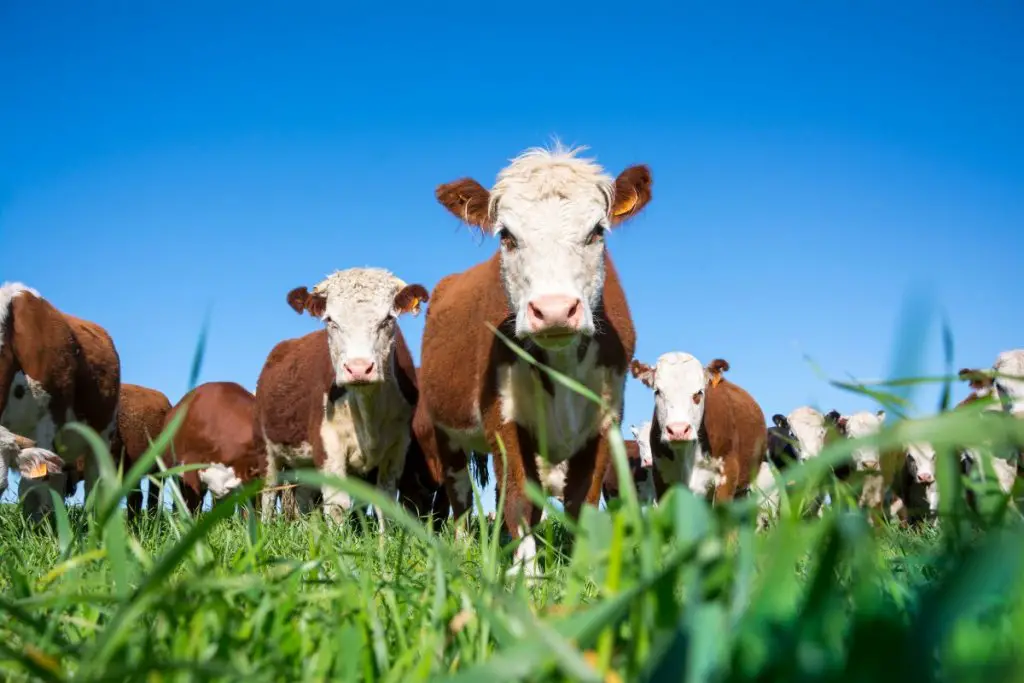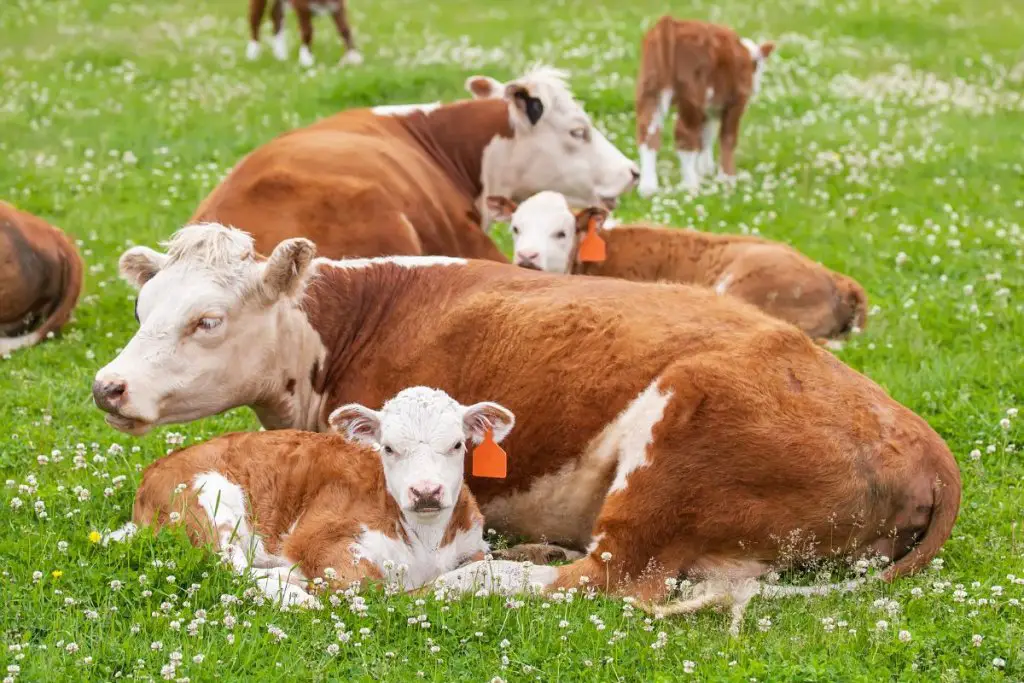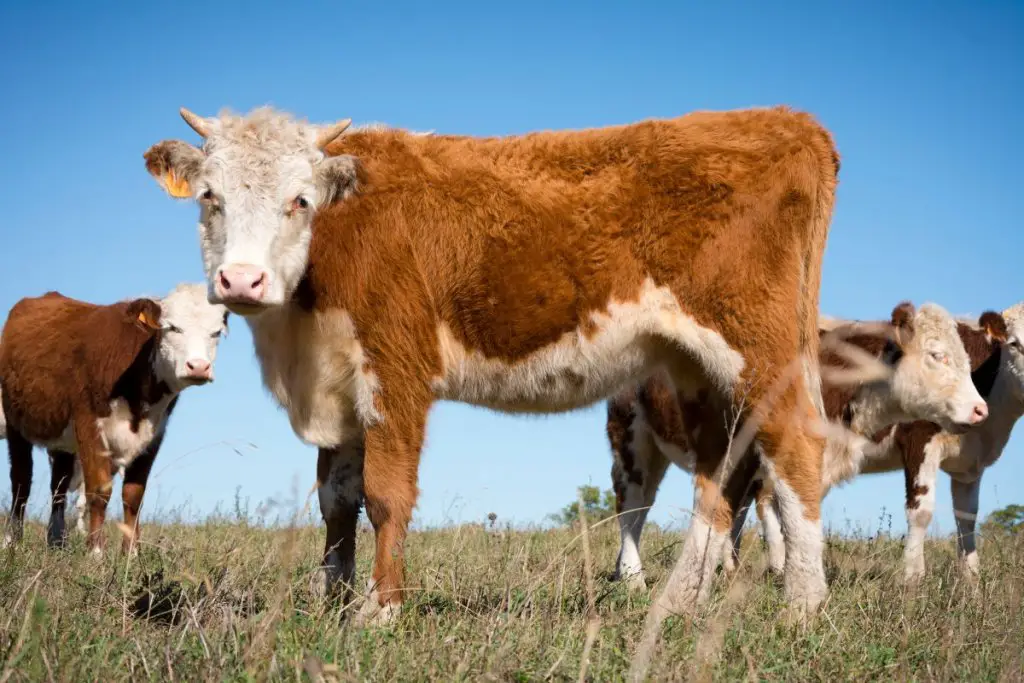Hereford cattle are among the most popular and prolific cattle breeds you can raise on your farm. They live up to 22 years but can be ready for slaughter in around 2 years, with their meat being good quality and tasty.
As with any other animal you keep, you must first do thorough research before tapping into the excellent qualities of this breed as a hobbyist, farmer, or rancher.
Here’s a high-level overview of the world-famous Hereford cattle to get you started.
Table of Contents
Hereford Cattle History and World Distribution
Hereford cattle developed from humble beginnings in Herefordshire County in West England, United Kingdom, to become the first English cattle to be recognized as a true breed.
The express origin of the British breed might have been lost to time, but the general agreement is that the cattle came into being from a large black Welsh cattle breed and from the draught ox that descended from the small Briton red cattle.
Mentions of the Herefordshire County origins of the Herefords date back to the 1600s, with breeding records noted during the 1700s and 1800s.
Benjamin Tomkins is widely acknowledged as one of the earliest Hereford breeders or founders of the Hereford breed in 1742, 18 years before Robert Bakewell’s development of his animal breeding theories.
Tomkins started with two cows named Mottle and Pidgeon and the bull calf of a cow named Silver. His goal was to develop a hardy, prolific, and early maturing breed that would be economical to feed.
The editor of the first herdbook published in 1846 identified four classes of Herefords categorized as:
- Red with white faces
- Mottle-faced
- Dark gray
- Light gray
Of the four classes, the last three had phased out about 25 years later, leaving only the red with white faces variety.

Today, there are over 5 million pedigree Hereford cattle worldwide, spread in countries like the United States, England, Mexico, New Zealand, Canada, South America, Australia, Scandinavia, Russia, Uruguay, Israel, Chile, Japan, Kazakhstan, and Brazil.
Hereford cattle are also found in Southern African countries like Zimbabwe, South Africa, and Zambia.
Henry Clay imported Herefords into the US in 1817 when he brought two cows and a young bull to his farm in Kentucky.
Fully-fledged importation of the Herefords started in the 1840s. Today, the American Hereford Association recognizes both Polled Hereford (hornless Hereford variant) and horned American Herefords.
Hereford Cattle Characteristics
Hereford cattle are not only famous for their iconic white faces. Their other notable characteristics include:
- Dark-red to red-yellow skin color. The dewlap, face, underline, and crest are white. Some have white markings below the hocks and knees and white flanks.
- Horned Herefords have short and thick horns (Polled Herefords are common in the UK and North America.)
- Mature Hereford males weigh up to 1,800 pounds. Mature cows weigh about 1,200 pounds. (The heaviest Hereford bull (called Cotmore) weighed 3,900 pounds in a bull show in 1839.)
- Color uniformity
- Excellent foraging ability
- Hardiness
- Excellent feed conversion efficiency and quick weight gain (High beef production efficiency)
- High libido
- Excellent mothering ability
- Early maturity
- High-quality Hereford beef
Hereford Cattle Personality
Animal temperament or personality is a crucial factor when choosing a cattle breed. It makes much sense on the farm since docile animals are safer and easier for ranchers and hobbyists to raise.
Herefords are generally docile cattle. They are human-friendly, easy to maintain, and quick to obey instructions, which makes them suitable for bull riding.

Despite their docility, Herefords can be pretty aggressive if they feel threatened. You won’t expect to threaten their territory and food or young ones and get away with it.
You also don’t want to invade their privacy, beat them up, scare them, or torture them. If you are lucky, you’ll just get an angry look and a tantrum involving raising the ears, snorting and kicking.
The best way to raise a docile herd is to socialize your beef cattle well from a young age to make them grow into reasonable animals that won’t become excessively defensive of their personal space or food.
Hereford Cattle Lifespan
A cattle breed whose members live long enough is preferable. If you are in the cattle industry for the beef bucks, you’ll want to keep animals that last the longest time possible in good health.

Herefords usually have a shorter lifespan than most cattle breeds. The average bovine lifespan is 20-25 years, but Herefords only average between 18 and 22 years.
As a consolation, a Hereford cow or bull raised outside on large pastures will live a little longer than most other cattle breeds because Herefords do great on pasture. They’ll also have more time to rest after grazing.
Hereford Cattle Health Issues
Although Hereford cattle are hardy and do well in extreme climates across different continents, they are not without their health flaws.
Firstly, Hereford cattle are prone to eye cancer, which may even spread to other body parts in extreme cases of infection. The cattle have large eyes that predispose them to the disease, especially in bright sunlight countries.
The affected cattle may die if not treated well and in good time. The life expectancy of a cow suffering from eye cancer is about three years.

Dwarfism is also common in Hereford cattle. According to the Oklahoma State University, Hereford cattle were originally quite big, but their size reduced over the years as people went for efficiency (better feed conversion versus huge sizes with poor feed-to-red-meat conversion rate.)
The cause of dwarfism in Hereford cattle is an autosomal recessive gene. If the condition manifests equally in bulls as in heifers, this type of dwarfism won’t be attributed to sex-linking.
Sunburn is another common health issue in Hereford cattle because of their pale udders. This is common in bright sunlight countries. The udder skin is lightly pigmented and thus prone to sunburn.
Hereford cows are prone to vaginal prolapse is either inherited or caused by nutrition issues.
You’ll have to watch out for these four health issues in your Hereford herd and treat the affected animals in good time.
